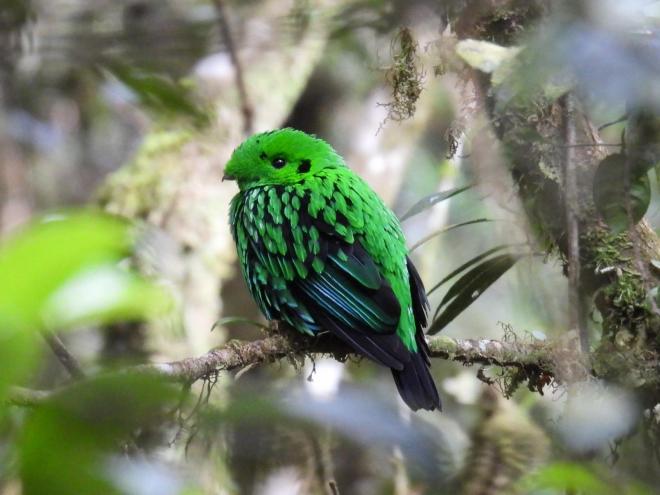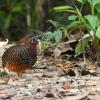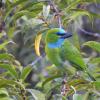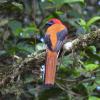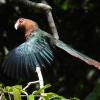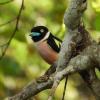Day 1 - March 15: Mid-day/early afternoon pick up from Kota Kinabalu Airport and transfer to Kota Kinabalu Shangri-La City Center Hotel. Time depending, we will do some afternoon birding around the city center where we will get our first taste of lowland Bornean birds such as Green Imperial-Pigeon, White-bellied Sea-Eagle, Nankeen Night-heron, Sunda Pygmy Woodpecker and hopefully, a few species of sunbirds such as Olive-backed, Crimson and Brown-throated. If we are up for an evening excursion, we may opt to try for Sunda Frogmouth and maybe even Barred Eagle-owl and Reddish Scops Owl at a local city park. We will spend the night at Kota Kinabalu.
Day 2 - March 16: We will get an early start in order to make the 1.5hrs transfer up to the Crocker Range where we will bird around the Gunung Alab Substation. An informal hide can attract both Red-breasted and Crimson-hooded partridges if we are lucky while the surrounding forest will give us our first taste of montane birding. Here we will be on the lookout for Mountain Blackeye, Sunda Bush Warbler, Black-sided Flowerpiercer and more. Along the main road to Tambunan we will make some birding stops for Mountain Barbet, Whitehead’s Spiderhunter, Bornean Leafbird and perhaps White-fronted Falconet or the scarce Mountain Serpent-Eagle. Depending on how our birding is going, after lunch we will continue birding this area or move on to a forested patch of road the other side of Tambunan near the Pheasant hide we will visit the following day. If we are up for an evening adventure, there may be an option to try for the scarce endemic Bornean Frogmouth. Night at Tambunan.
Day 3 - March 17: We will spend the morning birding the foothills forest around Tambunan. Among the star attractions for the area is the shy endemic Bulwer's Pheasant for which there is currently a hide where it can be seen with regularity. We will spend the first few hours of the morning at this hide which holds many wonderful birds though they are not always all reliable at any given time. Among these are Bornean Banded-Pitta, Crested Partridge, Orange-headed Thrush, Dayak Blue Flycatcher and a couple species each of babblers and bulbuls. In the surrounding forest we could spot Bornean and Mountain barbets, Buff-rumped Woodpecker, Long-tailed Broadbill, Orange-headed Trogon, Pygmy Helia and Bornean Bulbul. After lunch in Tambunan, we will make the 2.5 hr transfer to Kundasang, where we will spend the night.
Days 4 to 6 - March 18, 19 and 20: We will have three full days to bird the humid montane forests of Mount Kinabalu National Park and surroundings. Birding can be very productive and there are a whole suite of superb birds that we will be aiming to see here. Afternoons can be rather rainy and/or socked in with fog though and if this occurs we might spend an afternoon or two at somewhat lower elevations (perhaps around the Poring hot spring which is a great area for Rafflesia – the largest flower in the world!). In addition to the birds, this area has among the highest diversity of squirrels in the world including the adorable Tufted Pygmy Squirrel.
On Mt. Kinabalu we will likely encounter several mixed species flocks and these usually come in two varieties. Those dominated by laughingthrushes (Chestnut-hooded, Sunda and if we’re lucky Bare-headed) can also attract other larger birds such as the stunning Bornean Green Magpie, Black-and-crimson Oriole, Sunda Cuckooshrike and Checker-throated Woodpecker. The other type of mixed flock usually consists of smaller birds such as Chestnut-crowned Yuhina, Yellow-breasted and Mountain leaf warblers and White-throated Fantails. In these flocks one can often find White-browed (Blyth’s) Shrike-babbler, Bornean Whistler, Indigo Flycatcher and Temmink’s Sunbird.
Fruiting trees will be watched for carefully as these often attract goodies such as Fruithunter, Golden-naped Barbet and the extraordinary Whitehead’s Broadbill. Other top birds in the area include Whitehead’s Trogon (surely one of the more stunning species among a brilliant family of birds), Everett’s Thrush, Bornean Forktail, Bornean Stubtail, Black-sided Flowerpecker and Sunda Owlet.
Owling can be a bit tricky here but we will likely stay until post-dusk on one of our days here to try for Mountain Scops-owl and Brown Wood-Owl. We will spend these nights in Kundasang.
Day 7 - March 21: This will be a very early morning as we make the 2hr drive to the Telupid lowland forest, aiming to arrive not long after dawn. From here we will walk in ~1.5km to a hide for the almost mythical Bornean Peacock-Pheasant. The day will be largely dedicated to this special bird and while birding in this area is generally slow, we will see a few other species and these could include Bornean Crested Fireback, Fulvous-chested Jungle Flycatcher, Rufous-backed Dwarf-Kingfisher, Bornean Black-Magpie and a couple different species of barbets and babblers. In the afternoon we will continue driving another 3hrs to Sepilok.
Day 8 - March 22: We will have all day to bird around the Sepilok Lowland forest. We will spend the day at the Rainforest Discovery Centre (RDC) where there is a state-of-the-art canopy walkway with three towers. The area is good for woodpeckers and among others we may spot White-bellied, Maroon, Buff-bellied and Buff-necked. Hornbills are also regular and we can expect to see Oriental Pied, Rhinoceros, Black as well as perhaps others. If we are fortunate, we might come across a group of the bizarre Bornean Bristlehead, though we will have better chances later on in the Danum Valley.
Trails in the area can be good for species such as Rufous-collared Kingfisher, Red-naped Trogon, Black-crowned Pitta and a variety of babblers. The peculiar looking treeshrews, of a couple species, are fairly common here and it is likely we will run into a few. We can also hope to encounter our first wild Orangutans here and there is also a rehabilitation centre for them nearby.
We may opt to do a night walk at the RDC to look for Red Giant Flying Squirrels and a couple species of owl such as Sunda and Reddish Scops-owl and Barred Eagle-owl. Overnight at Sepilok.
Day 9 - March 23: We will have another opportunity to bird the area around Sepilok in the morning. If we didn’t already the previous day, we might decide to stake out a particular fruiting tree near the parking area of the Rainforest Discovery Centre where a variety of bulbuls (including the scarce Grey-bellied) and flowerpeckers (including Yellow-vented and the rare Brown-backed) can show up. After an early lunch we will make the 2hr transfer to the Gomantong Caves, near the Kinabatangan River where we will bird the rainforest for a time and then head into the caves where millions of bats as well as at least three species of switlets (Black-nest, Mossy-nest and White-nest) breed. As dusk approaches we will witness the spectacle of streams of bats leaving the caves and a few raptors such as Bat Hawk and Wallace’s Hawk-Eagle that attend in search of a meal. We will arrive after dark at our hotel, a 5 minute boat ride down the famous Kinabatangan River!
Day 10 - March 24: We will have all day to explore the Kinabatangan and will take full advantage with both morning and afternoon boat cruises, exploring the main river and a couple tributaries. This is a great area for hornbills and we can expect to encounter at least 6 species including the stunning Rhinoceros and Wrinkled as well as the endangered White-crowned Hornbill.
Along the tributaries we have opportunities to spot several stunning species such as Hooded and Black-crowned pittas, Black-and-yellow and Red-and-Black broadbills, Malaysian Blue Flycatcher, Diard’s Trogon, Blue-eared and Stork-billed kingfisher, the rare Straw-headed Bulbul, malkohas, sunbirds and more.
In the undergrowth we will hope to spot the endemic Sabah (formerly Chestnut-necklaced) Partridge and if we are very fortunate, the elusive Bornean Ground-cuckoo.
The riverside is great for raptors and Crested Serpent-eagles are common while we will have good chance of spotting Wallace’s Hawk-Eagle, Jerdon’s Baza, Bat Hawk and both Lesser and Grey-headed Fish-Eagle. This is the principal stronghold of the endangered Storm’s Stork and we should see a few as they often perch prominently atop riverside trees.
The Kinabatangan River is famous as the best spot to see the bizarre Proboscis Monkey and we can expect to encounter a few troupes over our day and a half here. Other mammals such as Sunda Colugo, Long-tailed and Pig-tailed macaques, and Silvered and Maroon Leaf Monkeys and perhaps even wild Bornean Orangutans and Bornean Pygmy Elephant can be found here as well.
On this evening we will have the option of doing a nocturnal excursion to look for Buffy Fish Owl, Large Frogmouth and mammals such as a few species of civet (Palm and Malay being the commonest) and Sunda Colugo .Overnight at the Kinabatangan River.
Day 11 - March 25: We will have a final morning to bird in the Kinabatangan area and look for any target species we may have missed as well as simply enjoy the luxury of birding and enjoying nature by boat.
After an early lunch we will transfer to Lahad Datu (2hrs) with a stop in at a hide for Giant Pitta en route. We will spend a couple hours at the hide and along with the Giant Pitta we could encounter Scarlet-rumped Trogon, Banded Broadbill and several species of babblers. Night at Lahad Datu.
Day 12 - March 26: This morning will be spent birding on Mount Silam, a hill above Lahad Datu where a hide for the elusive Blue-banded Pitta has recently been started. This gem will be the star attraction for the morning but there is a selection of other lowland birds in the area that will add to the fun. Scarce species such as Orange-headed Trogon, Speckled Piculet, White-necked Babbler and Rufous-tailed Shama can be found here with some luck.
After lunch we will make the 3hr transfer into the heart of the Danum Valley and the Danum Valley Field Centre, our home for the next three nights.
Days 12 & 13 - March 27 and 28: We will have two full days of birding in the Danum Valley. Along with a network of trails, birding the main road can be highly rewarding.
There a list as long as ones arm of special birds in the Danum Valley and these include stunning gems such as Great Argus Pheasant, Bornean Banded, Blue-headed, Giant and Blue-banded pittas, Green Broadbill, Banded Broadbill, Blue-banded and Rufous-collared kingfishers. This will be our best chance at the bizarre endemic Bornean Bristlehead as well as the endangered Helmeted Hornbill.
Among the more subtle specialties we will look for skulkers such as Black-throated, Striped and Bornean wren-babblers. Mixed flocks will hold a variety of babblers and bulbuls as well as perhaps White-bellied Erpornis and both Maroon-breasted and Rufous-winged philentoma. If we are fortunate, we might spot the monotypic Crested Shrike-jay.
Around the lodge itself we can look for a variety of spiderhunters, flowerpeckers and bulbuls attracted to the flowering and fruiting plants.
Danum Valley is excellent for mammals and we will fancy our chances of spotting a few Orangutans, several species of squirrels and with some luck Bornean Gibbons. Night excursions could provide us with encounters with civets, flying squirrels, Slow Loris and Horsfield’s Tarsier among the more likely. While very rare, this is one of the better spots for Clouded Leopard. On the nocturnal bird front, a few species of frogmouth are possible including Large, Gould’s and Blyth’s. Overnight in Danum Valley.
Day 14 - March 29: We will have a final morning of birding around the Danum Valley before we transfer to Lahad Datu airport for our afternoon flight back to Kota Kinabalu. The airport is good for Paddyfield Pipit and this may end up being our last new bird of the trip. Night at Kota Kinabalu.
TOUR ENDS

